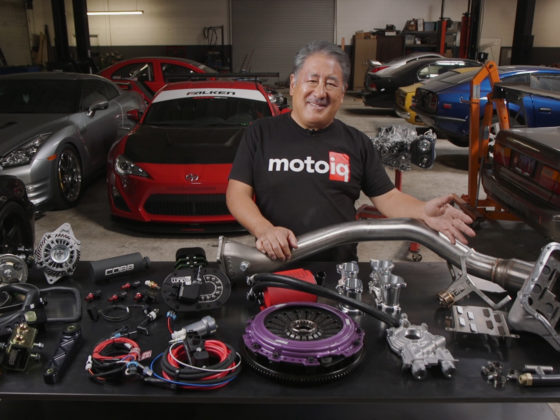
We got to get an early look at Ken Blocks super awesome 1400 hp, mid-engine, tube frame, unequal length A-arm suspension, AWD, Porsche 911 this week and boy are we impressed! In the near future, look for a complete feature on the car but for now, you can get a close look at the car’s aerodynamics as an unveiling party isn’t the place to do an all-out tech shoot! We had actually gotten a close look at the car under construction at BBi Autosport but the project was secret and there were embargos to respect. We can tell you the car bristles with a level of technology more akin to Prototypes and open-wheel racing than sedans and time attack cars. The chassis is tubular with a driver’s cell and narrow modules for the front and the rear with a possible structural carbon floor. The only Porshe body parts are the roof skin and the A and B pillars. The narrow front and rear sections allow for long arm, unequal length A-arm suspension with pushrod damper activation. The dampers are KW Motorsport solid piston 4-way. The suspension geometry which we can usually find fault with most custom builders is correct! The rear of the car uses a custom Sadev transaxle and transfer case, which with the engine block serves as structural members with the transaxle case serving to mount the rear suspension and wing. We will give you more details at a later date.

The car’s aerodynamics were developed by our friends at Verus Engineering and are the results of many hours of CFD optimization. They are many very subtle tweaks of the aero package that can only come about with CFD and you can see them in the car’s bodywork. Beyond the basics, aero isn’t intuitive and CFD allows the engineer to experiment with many surface geometries to a degree that isn’t possible with physical testing. It is a tool that results in the amazing shapes seen in F1 cars and this car. The aero is so complicated that we suppose that the bucks for the carbon panel molds were generated using a large bed 3D printer directly from the data generated by CFD.

We can start at the front of the car. One of the unique things about Pikes Peak is that it is run on public roads, roads that are in pretty bad shape on the top third of the course. The pavement is cracked and super bumpy due to frost heaving and changes during the course of the day. This means that Pikes Peak cars have to have relatively high ride heights and soft suspension. This is not conducive to the use of the underbody of the car for making a lot of consistent downforce. There are a lot of small details in the aero that helps the car make the most of the underbody even with a high ride height and softer suspension. The first thing we noticed is the aero elements are not ridiculously huge like what is found on many Pikes Peak cars. The air is thin at high elevations and many builders use ridiculously large elements to try and eek downforce out of the wispy air. Big front elements tend to be very pitch sensitive where chassis movement can cut off the downforce to the rear diffuser sort of like how a snowplow scoops up fresh snow. Ken’s car shows some subtle shapes to the underside of the moderately sized splitter to reduce pitch sensitivity. First, a moderately sized splitter isn’t going to come as close to the ground during brake diving, bump response, or cornering roll as a huge long one that overhangs the front of the car by a lot. You can see here that the center underside of the splitter is raised. This allows airflow under the car to feed the tunnels and rear diffuser even if the splitter gets close to the ground. You can also see the gentile bullnosed contour of the lower leading edge of the entire splitter. This reduces the cut-off effect that the front of the splitter can have on airflow as it gets near the ground plane.




15 comments
Whoa! Wow! That is as eloquent as I can be at the moment.
Really looking forward to seeing the full reveal and write up about this car. Take LMP1 levels of aero design, combine with a hint of 911, and wow! I can’t wait to see the suspension setup, with no constraints of a modified factory chassis. That will have allowed them to really design it exceptionally well from scratch. Again… wow!
BBI did a brilliant job with a turbo charged Porsche Cup car for Jeff Zwart a few years ago, and again with a newer modified Cup car that you reviewed two years back. It is great to see them continuing to take their work to ever higher levels.
It is not a factory chassis but a bespoke tube frame I think with a stressed carbon floor.
Sorry, I wasn’t clear! I meant I was looking forward to seeing how they did without constraints- being tube frame, they aren’t stuck within the parameters of a modified factory chassis (which many projects are). Complete freedom from design to one off construction 🙂
I thought so!
Well, that’s the proper way to build a 911! Look forwards to seeing under the skin.
Just wait! It is amazing.
I recently saw a video with some peeks under the skin of the old Pikes Peak Tacoma which was awesome but definitely of its time… so curious for comparison. But in general… I mean, my favorite 911s are the GT1 and the 935 (and the details around the tail on this are 100% 935 to me) so you can imagine why this is to my taste.
For a niggly technical thought, I wonder how much 3d printed composite molds have overtaken the older method of CNCing from tooling resin.
“Overall the car’s bodywork is supposed to generate 5000 lbs of downforce at 120 mph. ”
What’s the source on those downforce numbers, since they are rather . . . remarkable. Enviate (2017) was apparently pushing 6600lbs @ 100 mph. So apparently the Pigasus is making 16% less downforce at 16% more speed than Enviate. The Eagle MkIII GP with the twin tier wing is making 5217 lbs @ 150 mph. Yes Enviate and the Eagle MkIII have a lot less complexity, but aero complexity can’t make the difference in terms of sheer surface area, along with the intrinsic advantage prototypes have aerodynamically.
The source is from CFD testing using OpenFOAM. The numbers are a little optimistic based on the data if you average the ride height window the car will actually see. I will go out on a limb and say I doubt the Enviate is making 6,600lbs at 100mph. I could be wrong, but I do not think so based on data I have seen from our testing and testing at the top level of motorsports.
The hoonipig’s aerodynamics were designed specifically for a higher than normal ride height and a soft (in aero terms) mechanically set up the car. The whole underside of the car was designed to have a consistent downforce and balance throughout the range of motion for more useable downforce instead of peak numbers. This is specifically why certain details of the car are the way they are. Peak downforce wasn’t an important factor in the design or testing minus making sure there wasn’t a large peak. Downforce and balance is really a 3d surface map based on ride height front & rear, roll, pitch, heave, and speed. The goal is to make sure that map is as even as possible. In math terms, the goal is to have the largest and most even volume under the surface as possible.
I understand what you are trying to do with the aero map to ensure consistency over the run at Pikes Peak, since even compared with other hillclimbs Pikes Peak has awful road conditions. You say “the car was designed to have a consistent downforce and balance throughout the range of motion for more useable downforce instead of peak numbers.”, yet for a silhouette car, that’s sounds like a very high peak number for the speed. I would presume that’s approaching WTAC Pro class levels of downforce with what looks like a substantially less aggressive setup. I presume the 5000 lbs is the absolute peak in ideal conditions, but how far is that peak from the realistic running conditions? It’s just hard to wrap my head around the idea that with a more powerful floor design and aggressive front end, one can generate more than double what Feras’ C5 is able to create.
Also 2 quicker questions. How important are those turning vane behind the front wheels in creating overall downforce? And is their any good and free resources to learn OpenFOAM? I’m going to be helping my friend with running his NB MX5 in time attack.
Underbody downforce is so huge… I think looking at this car as a silhouette car is a bit misleading; obviously in this article we can’t see the full extent of what’s going on with the underbody, but I would expect that it’s less compromised than even open class WTAC.
I would expect the lift to drag isn’t spectacular however, given what it’s for.
That would be peak. How close it is to how it will be running will be hard to say until testing. I would say on the mountain, it will certainly be making less. This is two fold, elevation and conditions. Actual numbers will be hard to tell though until testing. The floor does make more downforce than the wing, even at high ride height. It is a pretty complex design.
Feras’s cars numbers aren’t peak numbers. I don’t quote peak. His car is also designed a little different. It is running a totally different splitter arrangement also and just a flat floor. Different designs with different goals and different budgets.
The turning vane behind the front tires are very complex. These are more of what I’d call a flow control device over downforce device. They do help produce downforce, upstream and downstream. Closer to Pikes Peak or after, we can do a write up on what is really going on aerodynamically around the car and get into them in detail.
There are a ton of resources for learning openfoam, certainly compared to when I learned. YouTube has a lot of great resources. Besides YouTube, I’d look at wolf dynamics pdf’s
Great write up! We worked hard to develop the body and aero while still keeping a specific look required. The whole team involved worked very hard to get the car done in record time. It’s pretty neat to see all the positive responses to the car, especially when you played a large roll in the development
I honestly love the front end; it looks so much like a 934 at first glance, but the cheeky way the lines are doing massively different things on this car are awesome.
Thanks! Oilstain did concept renderings of ideas on what it could look like. We made it racecar. They rendered again, tweaking the looks, and then we finessed it to make it work aerodynamically and manufacturable. It was certainly a lot of work and glad people like it.